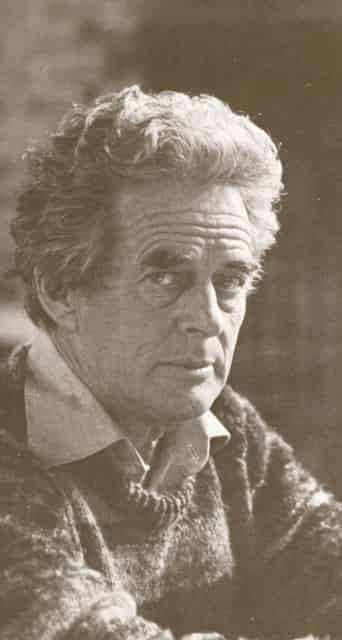Alistair Knox
 Alistair Knox
Alistair Knox
Alistair Samuel Knox (1912-1986), architect and builder, was born on 8 April 1912 at South Melbourne, second child of locally born parents Arthur Jean François Knox, clerk, and his wife Margaret Longmore, née Brown. Educated at Scotch College, at 15 Alistair began work as a clerk in the State Savings Bank of Victoria. On 20 March 1937 he married Mernda Mabel Clayton, a domestic arts teacher, at the college chapel. He began a part-time pottery course at Melbourne Technical College in 1941 but his studies were interrupted from June 1942 when his spare time was taken up by the Volunteer Defence Corps. Transferring to the Naval Auxiliary Patrol in 1943 and, next year, to the Royal Australian Naval Volunteer Reserve, he served in Papuan and New Guinean waters in the Martindale and was discharged in Melbourne as a leading seaman on 3 September 1945.
Resuming work at the bank, Knox also began studying architecture and building construction at Melbourne Technical College. While he did not complete the diploma, the course influenced him: in 1948 he resigned from the bank to explore the possibilities of building his own style of house. With the postwar shortage of building materials, and encouraged by an enthusiastic client in Frank English, he created his first earth building, a simple rectangle, at Montmorency. His next project was a study for William Macmahon Ball in the same materials at his Eltham home. For Knox, mud-brick was becoming his means of both survival and creative expression.
Drawn to the Montsalvat artists? colony centred on Justus Jorgensen, Knox moved with his family to Eltham in 1949. His developing architectural style was showing the influence of Frank Lloyd Wright, the inspiration of Francis Greenway and Walter Burley Griffin (including the latter?s preference for planting indigenous flora) and his admiration for the modernist work of Robin Boyd and (Sir) Roy Grounds. Buildings, landscape and environment began to merge in his work; as Bruce Mackenzie noted, a Knox house `grew in the landscape in the way that trees adapted ? to inevitable forces?. In landscape design he was particularly impressed by the work of Ellis Stones and Gordon Ford, whose espousal of `bush gardens? he helped to promote.
Knox?s career evolved over three distinct phases. In the first, from the 1940s to the 1960s, he followed Wright in embracing simple building structures. Notable houses from this period include the Ball, Busst and Le Gallienne-Downing houses. The more sophisticated designs of the second phase, until the late 1970s, incorporated the use of mud, stone and timber, as evident in the Coller (1974) and Huggett (1975) homes. A final phase came in the 1980s, when a Knox house was widely sought.
Even with this increasing popularity, Knox remained closely identified with the Eltham community. Mernda died in 1954, and on 15 September that year at the office of the government statist he married Margot, née Edwards, who had changed her name to Knox. Their home provided shelter, nurture and support for two generations of painters, potters, sculptors, poets and thinkers. In 1972-75 Knox was a councillor (president, 1975) on the Eltham Shire Council. He was drawn to the environmental movement, publishing three books on housing and the environment, writing for newspapers, speaking on radio, and hosting `open houses? to demonstrate his building and landscaping theories. Although academically unqualified, he was a founding member (1967) and fellow (1983) of the Australian Institute of Landscape Architects, and a frequent lecturer on environmental design, architecture, building and landscape. He received an honorary doctorate of architecture from the University of Melbourne in 1984.
Short, with intense eyes and a wiry physique, Knox evoked unequivocal responses. Remembered by his son Hamish?also a mud-brick builder?as `interested in everyone he met, enthusiastic, easy going, a raconteur, a lover of people?, he possessed, in Geoff Sanderson?s words, a `powerful memorable personality?. Above all, he presented a vision of integrating the earth?s elements into landscapes and living environments. He demonstrated how Australians could live in harmony with the landscape and established the mud-brick home as an attractive option for a wide cross-section of the Australian community. Christian beliefs informed his practice and wider social commitments.
Alistair Knox died on 30 July 1986 while visiting clients at Sunnycliffs, near Mildura, and was buried in Eltham cemetery. He was survived by a son and two daughters from his first marriage, and by his wife and their four sons and daughter. A park in Eltham is named in his honour.
Fay Woodhouse for the Australian Dictionary of Biography, Volume 17, (MUP), 2007
